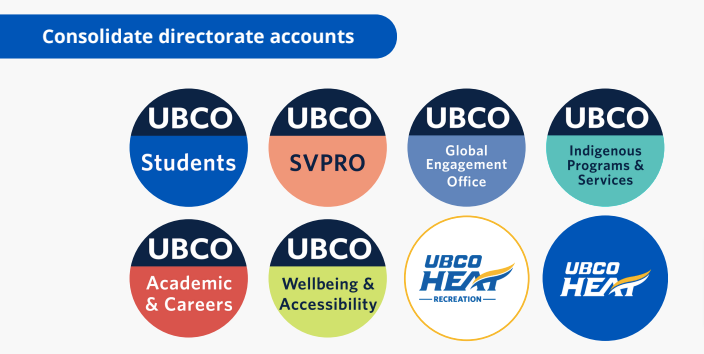Higher education marketers and communications teams are constantly grappling with the sheer number of social media accounts across campus.
When each unit, team, faculty, and degree has its own account, it’s near-impossible to figure out who’s sharing what and when. And creating a holistic social media strategy becomes a serious headache.
It makes it hard for students to know where to turn for information.
If all that sounds familiar, you’re in the right place. Christina Chin, Social & Digital Content Strategist at the University of British Columbia’s (UBC’s) Okanagan Campus, spoke at the Social Media Strategies Summit for Higher Education about building a coordinated, portfolio-wide communications strategy.
In this article, we’ve collated her top tips and insights, including:
- A framework for streamlining university social media communications
- Best practices for enhancing your team’s social media processes
- A real-life case study to support your attempts to consolidate accounts and align social media strategies
Let’s get into it.
Review and Streamline Active Social Media Accounts
Christina and her team’s efforts to build a coordinated student communications strategy began in summer 2022.
But even before then, they had long been aware that UBC had too many Instagram accounts — not just on the Okanagan Campus but also in Vancouver.
“It was really confusing for students,” Christina says. “They didn’t know who to follow or where to get information from, and there was no way to manage the information that was going out.”
In addition, it took a lot of work to find out who controlled each account. Students were running some, and when they graduated, there’d be no one to take over — so the account would become inactive.
“Many accounts were being overlooked and were having low impact, even though there was quite a bit of effort being put behind some of them,” Christina notes. “So the opportunity that we saw here was to create a coordinated, portfolio-wide strategy.”

The first step of the solution was to audit all active accounts and delete those that were unnecessary or underperforming.
But where to draw the line?
They couldn’t just delete accounts with low followings because those profiles might just be struggling due to a lack of resources.
Instead, Christina and her team decided to set a limit of one account per “directorate,” or student service area.
This resulted in them deleting more than half of their accounts, reducing the number from 19 to eight:

For instance, they consolidated all wellbeing and accessibility services — which used to have multiple separate accounts divided between the health clinic, counseling services, disability resource center, campus wellness, and more — into a single account.
All of this meant that a strategy and a dedicated delivery team backed up each remaining directorate account.
Get Buy-In From Stakeholders
Of course, deleting a bunch of accounts wouldn’t automatically fix the school’s student communications strategy.
Next, Christina and her team had to persuade the stakeholders at each directorate that a new, unified approach was necessary to provide better student service.
To do this, they capitalized on the growth of the university’s central Student Life Instagram account.
When Christina’s position was created, the account had 2,800 followers. Fast-forward to today, and it has more than 10,000.
Sure, it’s hardly the world’s biggest higher ed social media account, but it’s impressive given that fewer than 12,000 students are on the Okanagan Campus.

“We’re looked at as the number one source for all student information on campus,” Christina says. “We’ve really been able to build trust and credibility with students on our channel by being relatable and authentic.”
As well as using the account to raise awareness of the eight streamlined directorate accounts, it acted as a real-world case study for what Christina was trying to achieve.
This helped her to persuade stakeholders within each directorate that less is more when it comes to student comms. “We were able to explain to these staff members that we’re consolidating accounts to eight, but we’re going to provide extra support to each of these eight accounts,” she says.
Set Rules Around Account Activity
Before Christina’s overhaul, some of UBC’s social media accounts were accessible by multiple people, each of whom simply posted whenever they wanted to.
“There was no real strategy,” Christina explains. “It was hard to connect with someone about a post if you needed to because you didn’t know who was behind it.”
Something needed to change.
Their solution was to impose a three-person limit on access to each account.
Not only did this eradicate the previous scattergun approach to posting, but it also effectively created a team of “social people,” Christina says.
Even though these people weren’t professional communicators, there was a clear opportunity to help them create better, more helpful social media content by sharing best practices and educational resources.
Create Support Systems and Learning Resources
Next up, Christina developed best practice documents covering key areas of running an effective social media account, such as building a content plan and creating on-brand graphics in Canva.

But simply bombarding people with documents wouldn’t instantly change their behaviors.
Christina realized that another key element of her plan to develop a portfolio-wide social media strategy was to improve the lines of communication between her team and the people running each directorate’s social media account.
So, she created a Microsoft Teams channel and added everyone with access to one of those accounts. It gave her an easy way to answer questions, communicate changes in the social media landscape, and share important university messaging.
“Through this, each of these people went through a social media workshop, best practice training, and stuff like that so they could have a basic understanding before being able to post on one of our channels,” Christina explains.
Develop Account-Specific Strategies
Christina’s next task was to help the individual directorate accounts create dedicated social media strategies.

This included developing:
- Purpose statements to ensure everyone understood why their channel exists and its main goals.
- Voice depictions to guarantee a consistent tone of voice, no matter who shares content via each account.
- Content buckets to help define and silo the types of content each account would share.
“We discussed what works on the feed, what works in stories, and how we can batch content to help it make sense for students,” Christina explains.
Share On-Brand Design Assets
Because the people running each directorate account weren’t professional designers, they often relied on Canva templates when they needed to create branded social media graphics.
Sure, Canva is a fantastic tool. But its templates aren’t on-brand with UBC (or any other university) and are heavily overused.
To illustrate her point, Christina gathered examples of similar — or even identical-looking — content shared by different higher education institutions across North America.

“It wasn’t hard to find different accounts that were sharing the same templates because they’re so overused and oversaturated on Instagram,” she says. “It really makes it hard to stand out in the feed to make yourself look like an official communicator.”
Christina wanted the directorate accounts to share less generic content and was eager to ensure posts were accessible and contained proper calls to action where relevant.
On top of that, she was generally keen to make them look more fun.
With that in mind, Christina and her team assigned unique color palettes and branding patterns for each directorate account, with variations for individual units within a directorate.

They also developed custom icons and illustrations for each team.
“The goal is for everyone to look like they’re part of the same suite,” Christina explains. “We’re all part of the same institution, same campus, while still having our own look and feel.”
These branding efforts haven’t just made the university’s content look more attractive; they’ve dramatically affected engagement.

Case Study: UBC Okanagan Academic & Career Development
While Christina’s approach has been chiefly about creating better content on fewer accounts, she did launch one new profile as part of the process: UBC Okanagan Academic & Career Development.
It was converted from a defunct account that only had 600 followers — mostly staff and former alumni who would likely unfollow when it rebranded. Christina and her team deleted all the existing posts and then handed it over to three academic and career development unit members who had been through Christina’s social media workshop.
As such, this account provides the perfect case study for Christina’s strategy because all its growth can be directly attributed to the systems and best practices she’s implemented.
The results have been impressive.
Within its first year, the account attracted over 2,000 followers, and it’s now consistently generating 60,000+ monthly impressions. This compares favorably with UBC’s older, more established directorate accounts.
Importantly, students save and share the account’s content hundreds of times a month, showing they find it valuable.

“We’ve had great feedback from students on letting us know that this is super helpful, and we’ve just been really happy to see the success of this channel under the strategy,” Christina says.
Key Learnings
Unsurprisingly, Christina has learned plenty of lessons while developing and implementing her portfolio-wide social media strategy:
- When there’s a unified strategy that aligns with the mission, vision, and value of the area in which you work, your content will have a larger impact.
- Consolidating accounts to have fewer places for students to look results in higher engagement with events and programs. However, people can be very attached to their social accounts and may feel like you are taking something major away from them.
- Consistent communication through a community of practice to keep everyone updated on trends, social media updates, and university messaging changes the game.
- Most people just seek support to make things easier for their communications. If they seem resistant to change, remind them that you’re here to help and support them in your area of expertise so they can put all their energy behind their priorities and areas of expertise.
- This isn’t a one-and-done process. It’s something that needs to have someone leading it long term, who can ensure that content and designs stay fresh and new, someone who can onboard all new staff, and someone who can lead the community of practice. Social media is always changing — and your strategy will need to evolve.
Do you want more strategies, tips, and insights for higher ed social media marketers? Look out for our next social media conference!
Featured image by Freepik.










